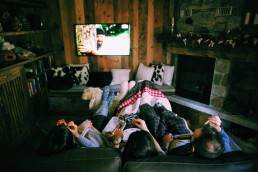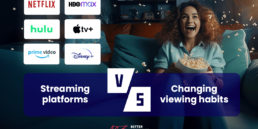Set-top box, over the top, live streaming, on-demand. You may come across these terms every now and then, especially when reading about online video streaming services and technology. You think you know what they mean, but do you really?
When living and breathing software development for the video, TV and media industry (like we do) it’s easy to forget that some people may not be actually up to date with your lingo and the basic concepts behind your work. We decided to write this quick post and catch you up on the nuts and bolts of streaming video.
So, first things first.
How do TV streaming services work
In a nutshell, streaming services are all about delivering video content over an internet connection to your device or connected TV. There are many ways to jump on the streaming bandwagon. Long story short: you need some video streaming hardware and a streaming service subscription.
Streaming hardware
Many smart TVs come with streaming capabilities built-in, but streaming is possible with any modern device connected to your TV: Android or Apple smartphone or tablet, laptop, game console, or a streaming device such as Apple TV and Google Chromecast.
What video streaming service providers are there?
There are many streaming services in existence today. It’s a vibrant industry. As we speak, new ones spring up like mushrooms, while others consolidate into bigger streaming platforms fighting tooth and nail for subscribers and dominance on the market. These services are often backed by insane budgets from various media and tech giants. Apple TV Plus and Disney+ launched in 2019. Comcast’s ad-supported Peacock launched in April 2020. Comcast’s ad-supported Peacock launched in April, and AT&T’s HBO Max premiered shortly after that in May 2020.
Today’s most popular TV streaming services include:
- Amazon Prime Video
- Netflix
- ESPN+ (for sports mainly)
- HBO Max
- Apple TV+
- Disney Plus
Do streaming services use a lot of data?
Long story short: yes. Because many modern video streaming services serve content in 4K (and very often with a 5.1 audio track on top of that), streaming two hours’ worth of content can consume anything between 6GB-12GB of data. Bingers beware – make sure you are on an unlimited internet plan, otherwise such extravagance could cost you some serious money.
What is a set-top box?
STB originally meant the black box (given to you by the cable provider) sitting “on top” of the TV set (hence the name). The term is still in use, but has now very little to do with cable TV providers.
Today the term set-top box is used to include all varieties of Apple TV, Fire TV, Android TV and Roku devices which plug into your TV’s HDMI port and allow you to access Netflix, Hulu and other video streaming services.
What is VoD (aka video on demand or on-demand video)?
On-demand video is video that’s pre-recorded, pre-compressed, and stored on servers. It’s delivered via CDNs to the users as they demand it (hence the name “on-demand video”). Video streaming services can serve VoD or live video. Sometimes they do both.
What is live streaming?
Before it’s delivered to your device, live video content needs to be captured and compressed in real-time. After the live stream is over, you can typically still access the content for a short period of time. Periscope and Snapchat keep live video streams available for 24 hours. On services like Facebook and YouTube, on the other hand, the streamer can decide to make the content available forever.
What is low latency streaming?
Low latency streaming is as close as the internet can get to being live. Sounds confusing? Let me explain.
Quite contrary to what the name would suggest, live streaming over common internet protocols is not, technically speaking, live. It’s low latency at best. There is always a compromise between quality and latency. Some streaming standards like the ubiquitous HLS are known to prioritize quality over low latency, which typically results in significant delays in live streams. The popular HLS streaming protocol is 30-45 seconds behind real-time, which is considered “normal” in live video streaming.
Of course, what counts as low latency is very subjective, but for reference, it’s worth to mention that HD cable TV content is only 5 seconds behind live. To close the gap, Apple has recently introduced low-latency HLS – a protocol that breaks down the streamed media into many smaller segments called CMAF Chunks. Players which support HTTP2 push can download smaller groups of frames to the player quickly after they are encoded. Good as this sounds, it only brings the delay down to 3-7 seconds. Not exactly live, still.
For more on low-latency streaming read this post on our blog.
What is an OTT media service (aka over-the-top)?
Over the top (OTT) is any type of video or streaming service that provides viewer access to movies or TV shows through the internet (i.e. without the use of antennas or requiring users to subscribe to a traditional cable or satellite pay-TV service). Most popular OTT providers match this definition, including Netflix, Amazon Prime Video, and Hulu.
Originally, the term “over the top” suggested a “better” service, one which went “over” the traditional cable provider’s walled garden limitations and enabled users to subscribe without being a subscriber of cable service.
Is VOD and OTT the same thing?
Yes, there is a certain conceptual overlap in the definitions, but the terms can’t be used interchangeably. Having heard people getting it all wrong over and over again, we decided it’s high time to set the record straight.
Naturally, there is some OTT/VOD confusion, but we can clarify that by saying that VOD is a very broad category, and OTT is only a subset of VOD.
A subset of VOD called “cable-supported VOD” is the traditional way and originally required you to have a cable subscription to access the streaming services. For many years, HBO Go used to work like this in many countries – it only came as a bonus to the existing cable subscription, and thus was not a real OTT at first (but it still fell under the definition of VOD).
By contrast, HBO Max is a standalone streaming service you don’t need a cable subscription to use – which makes it a fully-fledged OTT service.
How to access VOD services?
If you’ve been living under a rock for the past decade and somehow overslept the streaming revolution, here’s a cheat sheet of the different ways to access VOD services.
1. Through a Smart TV
Most modern Smart TVs come with Netflix, Hulu, and Prime Video apps pre-installed, which is very likely the cheapest and most convenient way to get started with VOD streaming. If you already own a smart TV, all you need is an active streaming service subscription to get you started.
2. Through a streaming device connected to your TV
Chromecast, Roku, Xiaomi Mi Box, Amazon’s Fire TV Stick, and many others – there is a whole bunch of devices that can turn your old, dumb plasma into a video streaming hub – without ruining your budget! All your TV needs is a spare HDMI port. To learn more about modern streaming devices, read our article about the recent Google Chromecast device.
3. Using an HDMI cable to connect your laptop to the TV
If no other options work for you, you can still go the traditional way – connect your PC to the TV with an HDMI cable and launch the OTT provider’s website. Simple as that.
Good luck!
If you find this article valuable, you can share it on social media →
Read more about the VOD & OTT Industry!
March 7, 2024
7 reasons why is sports streaming becoming so popular
Learn more about the reasons why sports streaming is becoming more and more popular right now.
February 29, 2024
Why should streaming platforms adapt to changing viewing habits?
Discover the strategies through which streaming platforms adjust to changing viewing habits.
February 20, 2024
What is Titan OS and what do we know about it so far?
Explore what distinguishes Titan OS, a new smart TV operating system. Discover its unique features before giving it a try yourself.
Are you looking for a partner to build a Video Solution?
Leave your email and a short description about your project. We would gladly discuss different cooperation possibilities!





